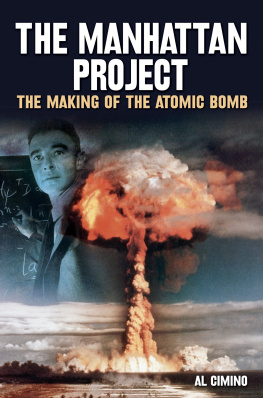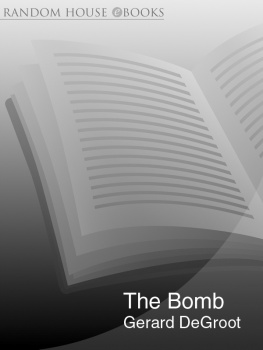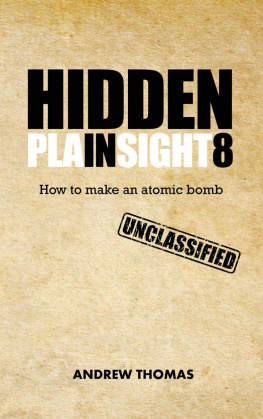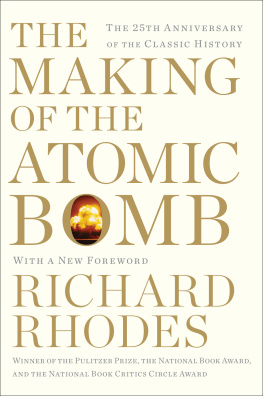Contents
About the Author
Born in California, Gerard DeGroot is Professor of Modern History at the University of St Andrews. He has written eight books on aspects of twentieth-century war, and is a regular columnist and reviewer for Scotland on Sunday.
Also by Gerard DeGroot
Douglas Haig: 18611928
Liberal Crusader: The Life of Sir Archibald Sinclair
Blighty: British Society in the Era of the First World War
A Noble Cause?: America and the Vietnam War
The First World War
Edited volumes
Military Miscellany
Student Protest
A Soldier and a Woman
Abbreviations
AAUW | American Association of University Women |
ABM | Anti-Ballistic Missile |
ADC | Air Defense Command |
AEC | Atomic Energy Commission |
ARP | Air Raid Precautions |
BHER | Basic High Explosive Research |
BNFL | British Nuclear Fuels Limited |
CEA | Commissariat lEnergie Atomique, French Atomic Energy Commission |
CND | Campaign for Nuclear Disarmament |
CPD | Committee on the Present Danger |
CTBT | Comprehensive Test Ban Treaty |
DOE | Department of Energy |
DSM | Development of substitute materials, codename for the Manhattan Project |
END | European Nuclear Disarmament |
EURT | East Ural Radioactive Trace |
FAS | Federation of Atomic Scientists (later changed to the Federation of American Scientists) |
FCDA | Federal Civil Defense Administration |
GAC | General Advisory Committee (US) |
GEN 75 | British Cabinet committee on nuclear policy |
IAEA | International Atomic Energy Agency |
ICBM | Intercontinental Ballistic Missile |
IEER | Institute for Energy and Environmental Research |
INF | Intermediate Nuclear Forces |
JCS | Joint Chiefs of Staff |
LIPAN | Alias for the Kurchatov Institute, also known as Laboratory Number Two |
MAD | Mutually Assured Destruction |
MARV | Manoeuvrable Re-entry Vehicle |
Minatom | Ministry of Atomic Energy (Russian) |
MIRV | Multiple Independently targeted Re-entry Vehicle |
MRV | Multiple Re-entry Vehicle |
NDRC | National Defense Research Council |
NKVD | Peoples Commissariat for Internal Affairs (Soviet secret police) |
NPT | Nuclear Non-Proliferation Treaty |
NSC | National Security Council |
NTS | Nevada Test Site |
OISM | The Oregon Institute of Science and Medicine |
OSRD | Office of Scientific Research and Development |
SAC | Strategic Air Command |
SALT | Strategic Arms Limitation Talks |
SANE | The National Committee for a Sane Nuclear Policy |
SBS | Strategic Bombing Survey |
SDI | Strategic Defense Initiative |
SED | Special Engineering Detachment (US Army) |
SIOP | Single Integrated Operating Plan |
SLBM | Submarine Launched Ballistic Missile |
START | Strategic Arms Reduction Talks |
TAC | Tactical Air Command |
Illustrations
. Enrico Fermi and Robert Oppenheimer ( Popperfoto)
. Hiroshima ( Bettmann/Corbis)
. First Soviet atomic reactor (Dr Raisa Kuznetsova)
. The Beginning of the End ( MGM)
. Doom Town mannequins (Las Vegas News Bureau)
. Miss Atomic Bomb (Las Vegas News Bureau)
. Aldermaston March, 1958 (Courtesy of CND)
. Greenham Common (Photograph by Janine Wiedel)
. Edward Teller and the Tsar Bomba (Courtesy of the estate of Dr Edward Teller) Every effort has been made to trace and contact copyright holders. The publishers will be pleased to correct any mistakes or ommissions in future editions.
To Dr Steve Greene, one-time neighbour of Klaus Fuchs, but, more importantly, someone who reminds me, every day, through my daughter Natalie, that scientists have also brought immense good.
THE BOMB
A Life
Gerard J. DeGroot
Preface
NOTHING THAT MAN has made is bigger than the Bomb. If your mountain is not in the right place, drop us a postcard, Edward Teller, the father of the H-Bomb, once quipped. To the nuclear wizards, the Bomb was not just a weapon, it was a tool for re-shaping the earth. Though the opportunities to move mountains proved few, a restructuring of the world did take place.
Many atomic physicists hoped that the Bomb would be big enough to destroy war itself. The idea seems nave. The atomic age has not, after all, been very peaceful. But the striking fact of the Cold War is that it remained cold. Though tens of thousands of nuclear weapons were made, after Nagasaki, none were used in anger. We cling to the hope that the bigness of the Bomb continues to be a deterrent against its use.
The sheer size of the Bomb is what makes the topic so attractive. It killed hundreds of thousands of people in a matter of seconds, condemned others to a lingering death and made vast tracts of land unfit for life. It has dominated the minds of those condemned to live in the atomic age, exerting its influence not just on politics, but also throughout popular culture.
Impressive books have been written on the Manhattan Project, the H-bomb, the Cuban Missile Crisis, nuclear deterrence and the disarmament negotiations. The detail of those books runs deeper than has been possible here. But detail was not my primary aim; I wanted to present the entire life of the Bomb in one volume in order to provide a sense of its size and a feeling for its ubiquity. All the main characters are here Oppenheimer, Teller, Kurchatov, Sakharov, Truman, Stalin, Churchill, Kennedy, Khrushchev, Reagan and Gorbachev. But Ive also included minor characters whose lives were affected by the Bomb: the anonymous technicians of the Manhattan Project, the cancer-ridden downwinders in Utah, the genetically damaged communities of Chelyabinsk, the campers of Greenham Common, the displaced peoples of Bikini. Like a great Hollywood epic, this book has a cast of thousands.
The bigness of the Bomb is both a blessing and a curse. I could have written a much bigger book, but I quickly exhausted the tolerance of a generous editor. I am tormented by what I have left out, not just because some areas deserve deeper discussion, but also because so many more good stories remain to be told. In deciding what went in and what got cut I made a strategic decision which I hope will make sense to the reader. It is my sincere feeling that the really big decisions about the Bomb were all made by around the time of the Cuban Missile Crisis. The revolt against the Bomb had evaporated, the H-Bomb was made, tests went underground and the superpowers accepted the doctrine of mutually assured destruction. The period after 1962 was characterized by the rapid progression down a road called proliferation which had been paved long before. The world (or at least most of it) had stopped worrying and had learned to love the Bomb.









